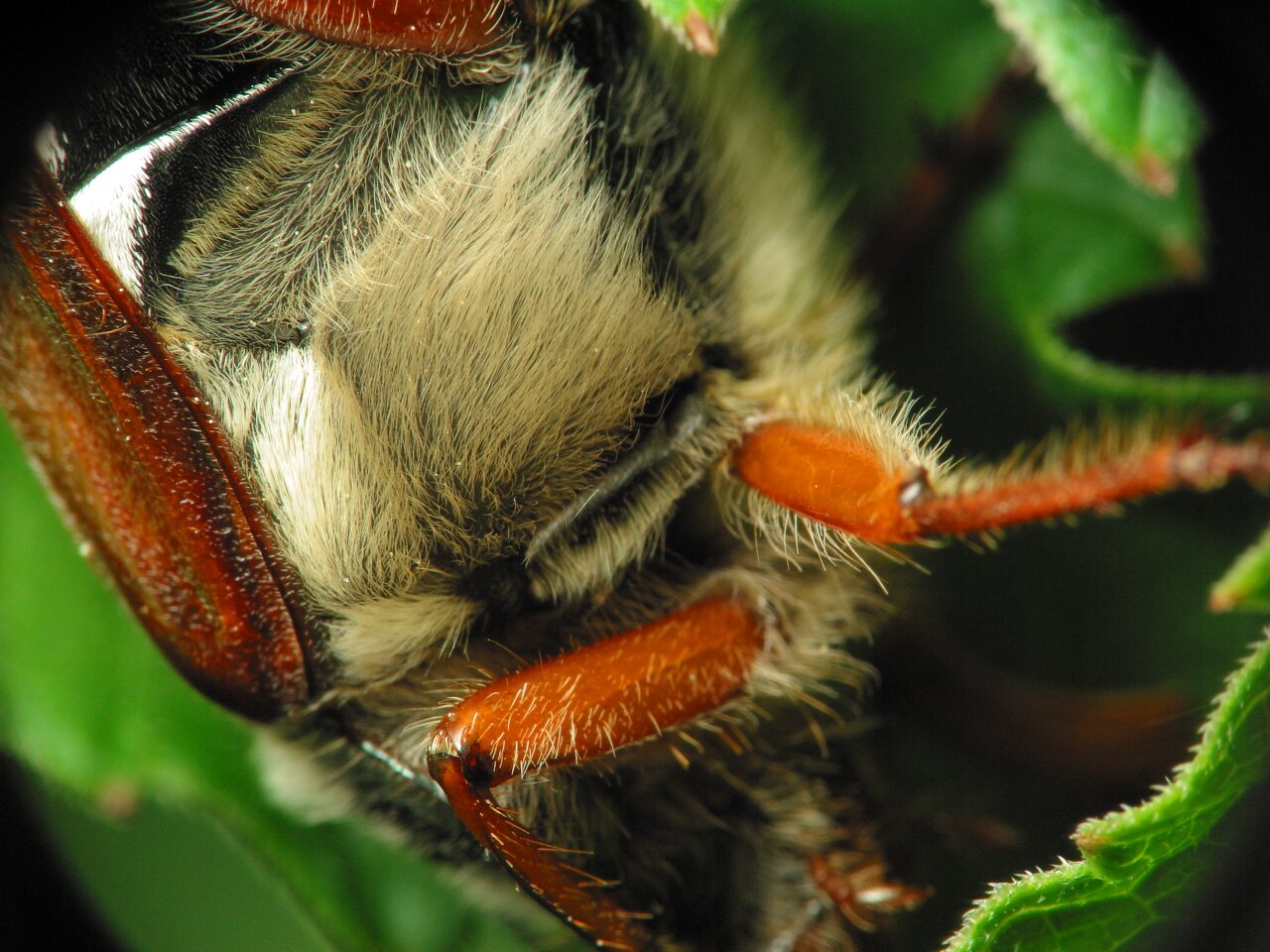
Melolontha melolontha · paprastasis grambuolys
- cockchafer, Maybug, Maybeetle, doodlebug
- Feldmaikäfer, Gemeiner Maikäfer
- paprastasis grambuolys, karkvabalis
- lauka maijvabole
- chrabąszcz majowy
Adults appear in early May and, because of the species long life-cycle, there are years of great abundance although this varies regionally and there is a longer cycle of around 30 years in which they occur, or at least did occur, in huge numbers. The typical habitat is broadleaf woodland margins, especially near arable or open grassland, wooded parkland and gardens etc. Adults rest during the day among foliage and fly towards feeding sites at dusk; they fly individually but large aggregations may appear swarming around and feeding upon the leaves of an individual tree which may then show severe defoliation, they are voracious feeders and will typically attack the young leaves of oak but a wide range of species have been recorded as hosts and there are records of them feeding on conifer needles. The males are strongly attracted to light and regularly appear in suitably placed moth traps and entering illuminated windows. They become mature after a week or so of feeding and mate during early or mid May, the mated females then fly away from their feeding sites towards open grass or crops where they will lay about 20 eggs among roots in the soil at a depth of between 10 and 20 cm. Many females die after ovipositing but some return to the trees and feed before ovipositing for a second or third time and some may lay up to 80 eggs during her lifetime. The adult season is generally over within five or six weeks.
The larvae hatch towards the end of June and immediately begin to feed on small roots, at this time feeding and growth is rapid and they may move through 30cm of soil each day in search of food. With the onset of cold weather the larvae move deeper into the soil, between 20 and 100cm, where they cease feeding and overwinter. Second year larvae work their way up through the soil during April and May and resume feeding voraciously until the autumn when they will descend and overwinter for a second time. During their third year they continue feeding, often near the surface, until June or July when they will burrow deeper and pupate in an earthen cell, the adults are fully formed by August or September but remain buried until the following spring when they make their way to the surface and fly in search of suitable host foliage. The life-cycle takes about 36 months spread over 4 years in temperate regions but in cooler areas may require an extra season of larval development, again with pupation in the summer and adults emerging the following spring. In numbers the larvae can be extremely destructive in a wide range of crops such as potato tubers and root crops, various cereals and grasses generally, the roots of fruit trees may be stripped and grape vines may be completely destroyed over large areas.
Kūnas 20 - 31 mm. Juodas, apaugęs pilkšvais plaukeliais. Antsparniai geltonai rudi. Augalų šaknims kenkia lervos, apgrauždamos jas. Lervos dirvoje gyvena 3-4 metus. Suaugusi lerva būna 60-65 mm ilgio. Grambuolio patelės kiaušinėlius deda dirvoje krūvelėmis po 25-30, 10-15 cm gylyje, ties augalų šaknimis. Iš pradžių jos maitinasi plonomis augalų šaknimis, mėgsta varpučio šakniastiebius. Žiemoti lervos sulenda giliau į žemę (kartais iki 1 m gylio). Pirmaisiais gyvenimo metais lervos didelės žalos nepadaro, bet labai kenkia 2-3-čiais vystymosi metais, kada būna ėdriausios. Trečiaisiais vystymosi metais, liepos – rugpjūčio mėn. lervos virsta lėliukėmis. Lėliukės fazė trunka 1-1,5 mėn.
Išsiritę vabalai lieka žiemoti lėliukių lopšeliuose, o skraidyti pradeda tik kitą pavasarį, gegužės mėnesį, prieblandoje. Orui atvėsus, vabalai būna nejudrūs ir slepiasi medžių lajose, o kartais ir dirvos paviršiuje.
Grambuoliai mėgsta lengvas priesmėlio ir smėlio dirvas. Vasarą jų lervų randama 10-20 cm gylyje, tai yra tame dirvos sluoksnyje, kuriame yra daugiausia organinių medžiagų. Kas penkeri metai gegužės - birželio mėnesiais skraido labai masiškai. Apgraužia įvairių lapuočių medžių ir krūmų lapus. Lietuvoje dažna rūšis.
‥
0 comments
Add a comment